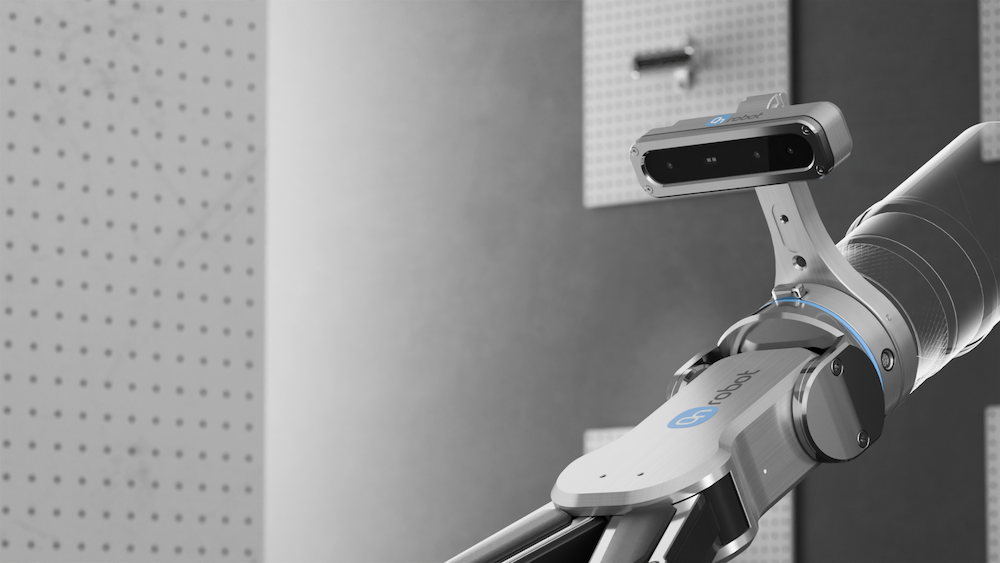
Eyeing up robot cameras: which dimension works for your application?
August 11, 2020
By Kristian Hulgard
When it’s time to add robot vision, consider the camera’s capabilities
 Photo: OnRobot
Photo: OnRobot “I think we need robot vision” is a statement that can strike fear into the heart of even the most seasoned robotics specialists.
This is because of a widespread perception that robot vision systems – comprising cameras, robots and supporting software – are complex, expensive, difficult to integrate and not entirely reliable.
Thankfully, it doesn’t have to be that way.
In fact, with the emergence of new technologies and falling costs, incorporating vision into your existing automation is now far more accessible; especially for collaborative robot (cobot) users.
Let’s look at the benefits of vision by comparing vision-enabled automation against “blind” systems.
We’ll explore some of the different camera options available and the upsides and downsides of each category.
Benefits of vision
Consider the complex set up that’s required for a traditional “blind” automation application to perform a simple pick-and-place task. The main challenge here is that objects have to be presented to your robots in exactly the same orientation and location every single time. This means installing costly fixtures and fittings and hardware such as bowl feeders, so that randomness is eliminated and your robots know precisely where the item to be picked is located.
Robots can perform superbly without vision, but what if you need to pick and place different objects? What if you want your automation to be capable of handling several types of objects arriving in different orientations? And what if you require rapid changeover times when switching between products?
In these scenarios, with flexibility and cost in mind, you should consider the benefits of adding robot vision – i.e., a camera and associated software – to your production lines. Vision eliminates the labour and capital costs associated with the addition of new hardware and fittings.
Vision brings flexibility to your operations, enabling you to switch between different products easily. And vision dramatically reduces the time required to move between one product and another – a massive boon for busy manufacturers, especially in today’s demanding, customized-production environment.
There are clear benefits to giving your cobot “eyes,” but not all vision solutions are the same. Variations in expense, flexibility, ease of use and software capabilities make a huge difference. So let’s take a look at different camera types typically employed in automation scenarios.
Which D is for me?
Robot cameras come in three main flavours: 2D, 3D and 2.5D.
2D cameras are the cheapest of the bunch, but are the least versatile. Typically, 2D cameras determine length and width (X and Y axis), but are unable to determine height, which limits the number of applications they can support. On the plus side, they are reliable within these constraints.
With some clever mathematics, the performance of 2D cameras can be improved – but that tends to be an inconvenient, time-consuming and somewhat unnecessary process, especially when more capable camera options are readily available.
3D cameras provide your robot with all the visual information it could possibly need, across all three axes and incorporating object rotation. This functionality comes at a price, however, since 3D cameras are the most expensive cameras and also tend to be difficult to integrate and operate.
Not all vision solutions are the same. Variations in expense, flexibility, ease of use and software capabilities make a huge difference.
Furthermore, 3D cameras have reliability issues that make many manufacturers reluctant to embrace the technology, despite the powerhouse capabilities.
2.5D cameras occupy a sweet spot between 2D and 3D cameras, both in terms of cost and capabilities.
Capable of determining the height of objects, 2.5D cameras are ideal for scenarios in which objects differ in height and when items need to be stacked.
Considerably less expensive than their 3D counterparts and considerably more capable than 2D cameras, 2.5D cameras (like OnRobot’s, pictured above) are often an ideal fit for a wide range of applications – especially applications where 3D cameras would be expensive overkill. That said, not all 2.5D vision systems are the same.
Some 2.5D systems are easier to set up and calibrate than others, some must be attached directly to your cobot, which restricts their capabilities, and some come with software that is, at best, clunky – so be sure to research.
Kristian Hulgard is general manager, Americas at OnRobot.
This article was reprinted with permission in the June 2020 edition of Robotics Insider, a quarterly e-book produced by Manufacturing AUTOMATION.
Advertisement
- Windsor Essex moving into Stage 3 of Ontario’s reopening plan on Wednesday
- Fiat Chrysler calls GM’s bribery allegations ‘preposterous’